Accepted Scientific Name: Agave potatorum cv. Kichijokan

Agave potatorum ''Kichijokan'' (marginata alba)
It is one of the most beautiful and highly sought after Japanese cultivars. It can be found under many different spelling (rarely seen this name spelled the same way twice)
Origin and Habitat: Garden origin (Nursery produced cultivar) This selection is thought to be a Japanese cultivar of Agave potatorum but some consider it to be a form of Agave parryi.
Synonyms:
Common Names include:
ENGLISH: Perennial Lucky Crown Century Plant
Description: Very attractive small growing rosette forming succulent, usually solitary and stemless. The bigger it gets the stronger the margination, spines, colour and global shape. (This cultivar shows a few different variegated forms and no two plant are exactly identical one to each other)
Rosette: Open spreading, symmetrical, hemispherical in shape up to 25 tall by 25 wide
Leaves: Short blue/grey with beautiful wide, up-curving, spoon-like shaped terminating in a wide upside-down "V". The outermost sides of the leaves have beautiful lateral, creamy-coluoured variegations (and occasionally also a pale green coloured variegation along the centre of each leaf). Nice imprints are present on the back side of the leaves. The edges are a purplish/maroonish colour. The leaves have large rusty coloured teeth and a long sharp terminal spine that contrasts well with the pale leaf colour.
Flowers: May bloom at maturity with a tall spike.
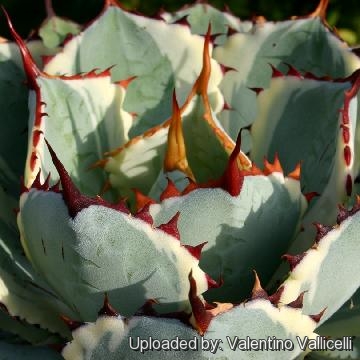 The leaves have large rusty coloured teeth and a long sharp terminal spine that contrasts well with the pale leaf colour. (Agave potatorum cv. Kichijokan) Photo by: Valentino Vallicelli
The leaves have large rusty coloured teeth and a long sharp terminal spine that contrasts well with the pale leaf colour. (Agave potatorum cv. Kichijokan) Photo by: Valentino Vallicelli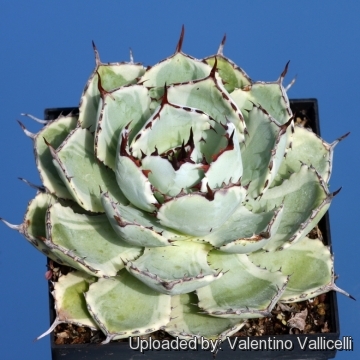 Agave cv. Kisshou-Kan (Agave potatorum cv. Kichijokan) Photo by: Valentino Vallicelli
Agave cv. Kisshou-Kan (Agave potatorum cv. Kichijokan) Photo by: Valentino Vallicelli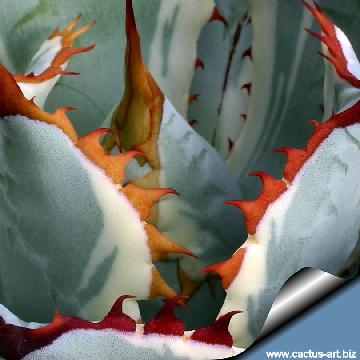 Agave potatorum cv. Kichijokan (leaf's teeth) (Agave potatorum cv. Kichijokan) Photo by: Cactus Art
Agave potatorum cv. Kichijokan (leaf's teeth) (Agave potatorum cv. Kichijokan) Photo by: Cactus Art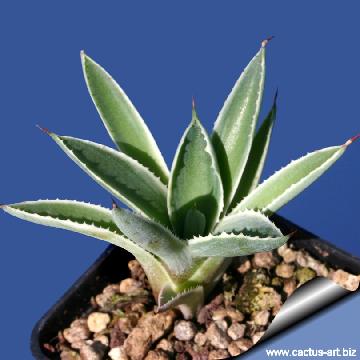 Agave potatorum cv. Kichijokan (young specimen) (Agave potatorum cv. Kichijokan) Photo by: Cactus Art
Agave potatorum cv. Kichijokan (young specimen) (Agave potatorum cv. Kichijokan) Photo by: Cactus Art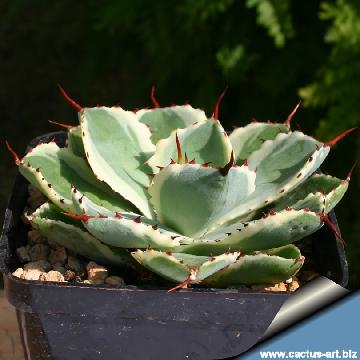 The degree of variegation is highly variable and depends also by levels of light, heat or feeding. (Agave potatorum cv. Kichijokan) Photo by: Cactus Art
The degree of variegation is highly variable and depends also by levels of light, heat or feeding. (Agave potatorum cv. Kichijokan) Photo by: Cactus Art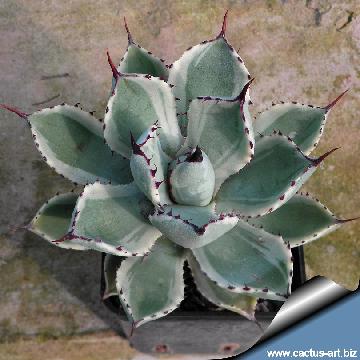 This Agave is an outstanding container plant because of its smaller size, beautiful colour and regular proportions. (Agave potatorum cv. Kichijokan) Photo by: Cactus Art
This Agave is an outstanding container plant because of its smaller size, beautiful colour and regular proportions. (Agave potatorum cv. Kichijokan) Photo by: Cactus Art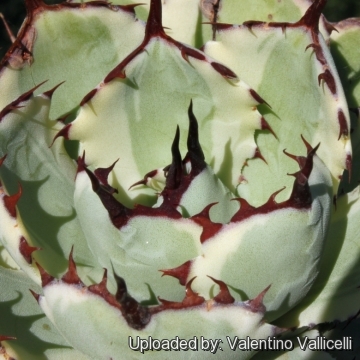 Agave cv. Kisshou-Kan (Agave potatorum cv. Kichijokan) Photo by: Valentino Vallicelli
Agave cv. Kisshou-Kan (Agave potatorum cv. Kichijokan) Photo by: Valentino Vallicelli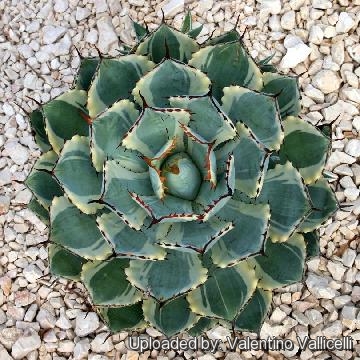 A. potatorum ''kiji-jo-kan'' is a very unusual, rare coloured form with amazing symmetrical lotus like leaf pattern. (Agave potatorum cv. Kichijokan) Photo by: Valentino Vallicelli
A. potatorum ''kiji-jo-kan'' is a very unusual, rare coloured form with amazing symmetrical lotus like leaf pattern. (Agave potatorum cv. Kichijokan) Photo by: Valentino VallicelliCultivation and Propagation: Agave potatorumSN|540]]SN|540]] is a relatively easy-to-grow species, though not as cold-hardy as many of the more northerly-occurring species (Winter hardy to around -3° C degrees) But it is best to protect it from frost to avoid disfiguring the foliage. Suited for light shade to full sun, but better with some shade in summer. It needs a very well-drained soil. It grows fairly fast in summer if provided with copious water, but allow to dry thoroughly before watering again (the more water and fertilizer this plant gets, the faster it will grow). During the winter months, one should only water enough to keep the leaves from shrivelling.
It does great in containers. Plants cultivated outdoors are more drought tolerant, and can take some heat and some sun. Remove eventual suckers to show of the beauty and form of the individual rosette.
Propagation: Relatively easy to propagate by suckers (if available) Remove the basal suckers in spring or summer and let the cuttings dry for a few days before inserting in compost.. only problem is the logistics of getting to the suckers - very sharp spines and suckers usually right up against, or underneath the mother plant.
Uses: These striking plants are wonderful when used for accent or simply to provide some all year round foliage colour and often used in a pot as a patio plant, they make an eye-catching statement and along with other evergreen plants in pots, can be moved around to change the scenery or position to give more shelter.
Your Photos

by Valentino Vallicelli



















